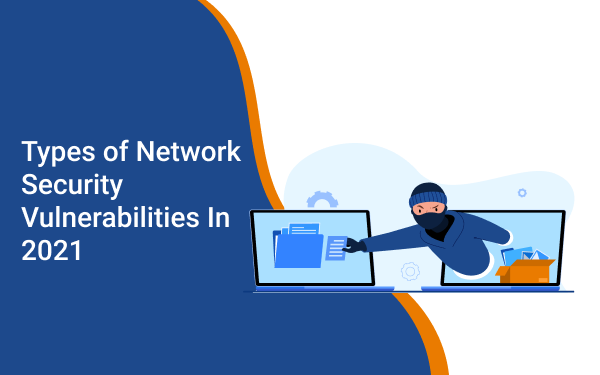Technology
Types of Network Security Vulnerabilities In 2021
The network security vulnerabilities and threats are constantly evolving and becoming more frequent nowadays. The probability of these threats cascading into the full-blooded attack is higher than ever.

The exploitation of exposures can cause data breach and network system security breach. The malicious attackers are evolving and seeking new and innovative ways of exposing the vulnerabilities and breach into the business networks.
Here we will have a look at types of network security vulnerabilities in 2021.
What is a Network Security Vulnerability?
A security vulnerability is a weakness, error or a flaw in a network system that a malicious actor can leverage to launch a full-blown attack, resulting in compromised network systems causing a data breach.
The vulnerabilities can be categorised as:
Non-physical vulnerabilities: which typically involves software, applications are data.
Physical vulnerabilities: Include vulnerabilities related to physical assets such as servers or physical systems where critical data is stored.
Types of Network Security Vulnerabilities
Network vulnerabilities can be broadly classified into 4 types
Malware:
Those are installed or injected unknowingly into the target system to exploit the vulnerabilities. The systems infected with malware show certain symptoms like slow processing, starting unknown processes or randomly rebooting.
The different kinds of Malwares are as follows
Viruses
Viruses are the most common type of Malware attacks send through mails or messages. Viruses require the user to click on the link or messages sent. Once clicked, it self-replicates into the system and starts attacking the vulnerabilities.
A virus can easily transfer from one system to another through Emails, messages, removable media, and malicious downloads.
Worms
Worms are malware programs similar to viruses that can rapidly self-replicate and spread full copies and segments of themselves into other programs.
Unlike viruses, worms do not require a host program to run; they can do so as a standalone program.
Trojan Horse
Trojan Horse is a malicious code or software that tricks users into downloading or running it by disguising itself as software or hiding behind a legitimate program or software.
When called upon or activated a trojan Horse enables the attacker to spy or steal sensitive data and gain access to the network systems.
These are often sent through email attachments, website or application downloads and through instant messages.
Ransomware or Crypto ware
Ransomware is a type of malware that often gains unauthorised access to the user’s system and locks them out of it, denying them access to their personal data until a ransom is paid.
Crypto ware is a type of Ransomware wherein the attacker gains access to the user’s system, encrypts user files and data and denies them access until a payment generally in the form of bitcoins is made.
Adware and Spyware
Adware is basically software or a code that is embedded into your browser and tracks your browsing habits. Through your browsing habits, the Adware bombards you with advertisements and pop-ups. Adware is sometimes downloaded without your consent and is malicious.
Spyware is similar to Adware and is installed in your system without your knowledge or consent. It can also contain keyloggers that documents or keeps track of personal information such as passwords, credit card details, bank details etc.
Spywares can result in extensive data breach and attackers can use compromised information for identity theft for causing further damage.
Rootkits
Rootkits are programs or software hidden in a program and enable remote control and administration-level access over a computer network to the attacker.
The attacker can gain full access to the computer or networks once they gain remote access. The rootkit contains tools like a keylogger, password snatchers and antivirus disablers.
Rootkit replicates itself and downloads into the system once a user gives it access or downloads a malicious program unknowingly. The rootkit is then activated remotely by the attacker, who gains full access of the system.
Read Also: Identifying Threats and Vulnerabilities in Network Security
Social Engineering vulnerabilities
Cyber-attacks where hackers attempt to manipulate or trick people into providing sensitive personal information such as account details or granting access to networks or systems is known as social engineering attacks.
By tracking one’s digital footprint, hackers gather information regarding an organisation, its employees, and its vendors. Then they craft general or targeted phishing campaigns by impersonating authority figures or by playing on the person’s emotions to gain access to personal information or credentials.
Social engineering is considered to be one of the greatest security threats facing individuals and organisations. The main reason for them being so effective is that the attacks are persuasive and very deceptive.
Here are some common types of social engineering attacks,
Phishing emails:
Are attacks sent in the form of links embedded within an email? The email will look like it has been sent from a legit user business or website when it is a link to a malicious site that attempts to trick users into opening or downloading applications where they would have to provide sensitive information such a username and password.
Whaling:
Is a type of phishing attack targeting high profile business executives or managers who possess more critical information? Whaling emails are different from other phishing mails as they are crafted to appear more official.
Vishing:
Here hackers try to trick victims into providing sensitive information over the phone. They attempt to strategically manipulate victims by playing on emotions such as fear, sympathy and or greed.
Smishing:
It is a social engineering attack that uses SMS messages to trick its victims into providing sensitive personal information. The text messages invite users to click on URL embedded short links, which redirect them to malicious sites.
Spam:
Is an attempt to send mails in bulk to a large number of people? The emails contain scams and hoaxes attempting to trick people into investing or donating money to fake schemes or organisations.
Outdated software’s or unpatched vulnerabilities
As attackers are finding innovative ways to exploit the vulnerabilities the developers are faced with challenges with mitigating the new evolving threats through software updates or software patches.
Software updates or patches fix the bugs and errors to reduce the probability of exploitation of the vulnerabilities. If these patches or updates are not installed in time the user’s system is at a risk of a full-blown evolving attack.
Misconfigured Firewalls and Operating systems
A significant vulnerability or threat to an organisations network is exposing the internal system to internet. Through the internet, the attackers can easily spy or steal your data or launch an attack to access your system.
As the name suggests, a firewall acts as a shield or a wall in between the organisation’s network and the internet. Firewalls monitor the inbound and outbound traffic and limit traffic flow based on as set of rules or how it is configured.
If a firewall is misconfigured, it makes it easy for attackers to launch an attack against the underlying systems. Operating Systems can have weaknesses like other software’s.
Operating systems that are vulnerable by default and give all users full access serves as an entry points to viruses and malware to execute malicious commands.
Conclusion:
Defending against network vulnerabilities is a complicated and tedious process. Every system or devices, every piece of software, and every person on the network can participate to cyber security or be a risk factor.
Frequent reviews of security policies and best practices are essential. Employee’s awareness plays a vital role to overall cyber security posture of the organisation.
Network Penetration Testing Providers have the necessary skills and expertise to discover the security weaknesses in your network which can help you to quickly fix them before your organisation becomes the next target.





